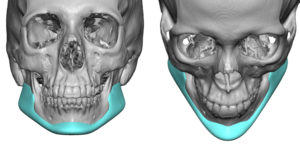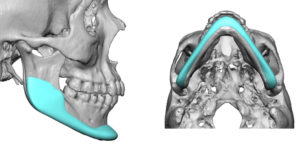Jawline augmentation has been historically perceived, and is still done so today by many plastic surgeons, as augmentation of the chin. But the chin is just the anterior portion of the jaw and represents less than one-third of its total bony mass. Jawline augmentation really refers to either isolated jaw angle augmentation or complete augmentation of the entire jawline.
Jawline augmentation, either restricted to the jaw angles or includes all of the lower jaw’s outer surface, is commonly perceived as an aesthetic male facial procedure. But more women are requesting the procedure than ever before. And they are not just seeking chin augmentation but an entire jawline effect.
As a general rule a one-piece design provides the most effective method for an entire jawline augmentation effect. But the designs for man and women are predictably different. Having designed and placed many such implants there are definite trends in size and shape that differ amongst the genders.


Lastly the connection between the chin and the jaw angles, known as the body component, has gender differences. Most women want a smooth linear connection between the two so the body part of the implant has an even outer thickness to remain confluent with the front and back of the implant design. Men, conversely, may need with throughout the jawline so it is thicker. Even if it is thin, in most cases, there is a discrepant thickness from that of the chin and jaw angles.
Dr. Barry Eppley
Indianapolis Indiana


